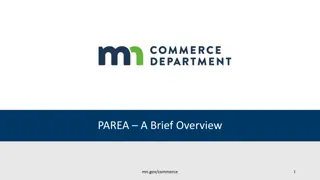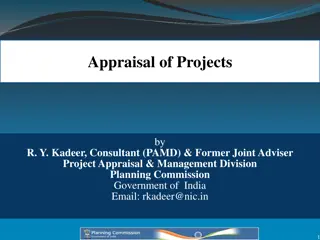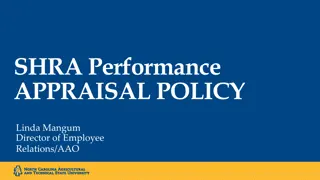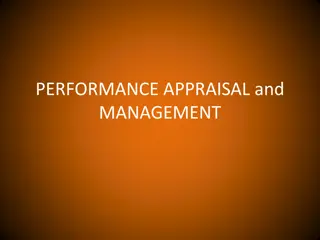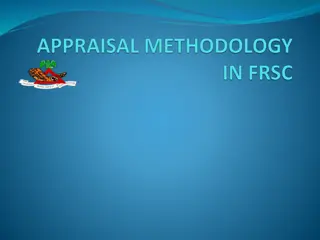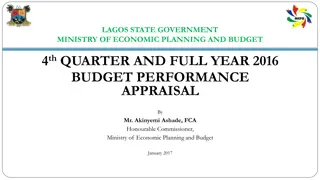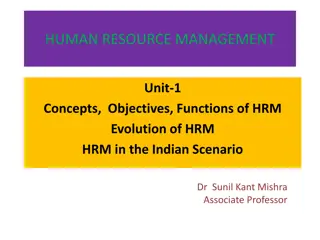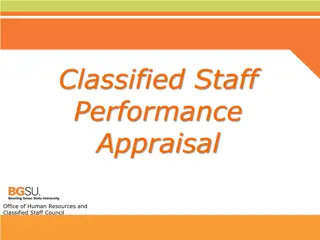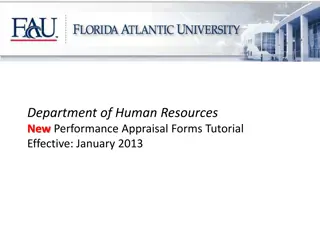Introduction to Performance Appraisal in Human Resource Management
Performance appraisal is a vital process for evaluating employee performance, identifying strengths and weaknesses, providing feedback, and guiding organizational development. Originating in the 20th century, it aims to align individual contributions with organizational goals through systematic evaluation methods. Objectives include compensation determination, skills assessment, and feedback provision, supporting decision-making for promotions, transfers, and training programs.
Download Presentation

Please find below an Image/Link to download the presentation.
The content on the website is provided AS IS for your information and personal use only. It may not be sold, licensed, or shared on other websites without obtaining consent from the author.If you encounter any issues during the download, it is possible that the publisher has removed the file from their server.
You are allowed to download the files provided on this website for personal or commercial use, subject to the condition that they are used lawfully. All files are the property of their respective owners.
The content on the website is provided AS IS for your information and personal use only. It may not be sold, licensed, or shared on other websites without obtaining consent from the author.
E N D
Presentation Transcript
Human Resource Management Anu Veerendra Assistant Professor
Introduction Essential for the effective management and evaluation of staff. Appraisals help develop individuals, improve organizational performance, and feed into business planning. Formal performance appraisals are generally conducted annually for all staff in the organization.
The history can be dated back to the 20th century and then to the second world war when the merit rating was used for the first time. An employer evaluating their employees is a very old concept. The latest mantra being followed by organizations across the world being "get paid according to what you contribute
Meaning Performance Appraisal is the systematic evaluation of the performance of employees and to understand the abilities of a person for further growth and development. Performance appraisal is generally done in systematic ways which are as follows: The supervisors measure the pay of employees and compare it with targets and plans. The employers are in position to guide the employees for a better performance.
Objectives of Performance Appraisal Performance Appraisal can be done with following objectives in mind: 1. To maintain records in order to determine compensation packages, wage structure, salaries raises, etc. 2. To identify the strengths and weaknesses of employees to place right men on right job. 3. To maintain and assess the potential present in a person for further growth and development. 4. To provide a feedback to employees regarding their performance and related status. 5. It serves as a basis for influencing working habits of the employees. 6. To review and retain the promotional and other training programmes.
Need for Performance Appraisal Performance appraisal is needed in order to: Provide information about the performance ranks based on which decision regarding salary fixation, confirmation, promotion, transfer and demotion are taken. Provide feedback information about the level of achievement and behavior of subordinate. This information helps to review the performance of the subordinate, rectifying performance deficiencies and to set new standards of work, if necessary. Provide information which helps to counsel the subordinate. Provide information to diagnose deficiency in employee regarding skill, knowledge, determine training and development needs and to prescribe the means for employee growth provides information for correcting placement. To prevent grievances and in disciplinary activities.
Purpose of performance appraisal Administrative purposes: Document HR decisions with regard to performance and its related issues. Determine promotion of employees. Determine transfers and change in job assignments. Identify poor performance areas of employees. Decide retention or termination.
Decide on layoffs. Validate Selection criteria relating performance scores to selection test and interview scores. Meet legal requirements. Evaluate the performance of training programmes Plan for changes in HR requirements. Decide on salary and reward issues.
DEVELOPMENT PURPOSES: Provide performance feedback to all concerned. Identify individual skills, core competencies, strength and weaknesses. Recognize individual performance levels. Assist the employees in setting goals/ identifying goals based on unit level/departmental level and organizational goals. Evaluate goal achievement of employees. Identify individual training needs. Determine organizational training needs Reinforce authority structure. Allow employees to discuss concerns. Improve communication. Provide a forum for leaders to help the subordinates.
Advantages of Performance Appraisal It is said that performance appraisal is an investment for the company which can be justified by following advantages: Promotion: Performance Appraisal helps the supervisors to chalk out the promotion programmes for efficient employees. In this regards, inefficient workers can be dismissed or demoted in case. Compensation: Performance Appraisal helps in chalking out compensation packages for employees. Merit rating is possible through performance appraisal. Performance Appraisal tries to give worth to a performance. Compensation packages which includes bonus, high salary rates, extra benefits, allowances and pre-requisites are dependent on performance appraisal. The criteria should be merit rather than seniority.
Employees Development: The systematic procedure of performance appraisal helps the supervisors to frame training policies and programmes. It helps to analyse strengths and weaknesses of employees so that new jobs can be designed for efficient employees. It also helps in framing future development programmes. Selection Validation: Performance Appraisal helps the supervisors to understand the validity and importance of the selection procedure. The supervisors come to know the validity and thereby the strengths and weaknesses of selection procedure. Future changes in selection methods can be made in this regard.
Communication: For an organization, effective communication between employees and employers is very important. Through performance appraisal, communication can be sought for in the following ways: Through performance appraisal, the employers can understand and accept skills of subordinates. The subordinates can also understand and create a trust and confidence in superiors. It also helps in maintaining cordial and congenial labour management relationship. It develops the spirit of work and boosts the morale of employees. All the above factors ensure effective communication. Motivation: Performance appraisal serves as a motivation tool. Through evaluating performance of employees, a person s efficiency can be determined if the targets are achieved. This very well motivates a person for better job and helps him to improve his performance in the future.
Disadvantages of Performance Appraisal: First Impression (primacy effect): Raters form an overall impression about the ratee on the basis of some particular characteristics of the ratee identified by them. The identified qualities and features may not provide adequate base for appraisal. Halo Effect: The individual s performance is completely appraised on the basis of a perceived positive quality, feature or trait. In other words this is the tendency to rate a man uniformly high or low in other traits if he is extra-ordinarily high or low in one particular trait. If a worker has few absences, his supervisor might give him a high rating in all other areas of work. Horn Effect: The individual s performance is completely appraised on the basis of a negative quality or feature perceived. This results in an overall lower rating than may be warranted. He is not formally dressed up in the office. He may be casual at work too! .
Excessive Stiffness or Lenience: Depending upon the raters own standards, values and physical and mental makeup at the time of appraisal, ratees may be rated very strictly or leniently. Some of the managers are likely to take the line of least resistance and rate people high, whereas others, by nature, believe in the tyranny of exact assessment, considering more particularly the drawbacks of the individual and thus making the assessment excessively severe. The leniency error can render a system ineffective. If everyone is to be rated high, the system has not done anything to differentiate among the employees. Central Tendency: Appraisers rate all employees as average performers. That is, it is an attitude to rate people as neither high nor low and follow the middle path. For example, a professor, with a view to play it safe, might give a class grade near the equal to B, regardless of the differences in individual performances. Personal Biases: The way a supervisor feels about each of the individuals working under him - whether he likes or dislikes them - as a tremendous effect on the rating of their performances. Personal Bias can stem from various sources as a result of information obtained from colleagues, considerations of faith and thinking, social and family background and so on.
Spillover Effect: The present performance is evaluated much on the basis of past performance. The person who was a good performer in distant past is assured to be okay at present also . Recency. Rating only recent performance, good or bad. Data should be representative of the entire review period. If you re not keeping good notes, you may not remember the whole period. Armstrong noted that "you want to make sure, again, that you re keeping records so that you can adequately describe performance over an entire performance period." The sunflower effect. Rating everyone high, regardless of performance, to make yourself look good or to be able to give more compensation.
Supervisors Supervisors include superiors of the employee, other superiors having knowledge about the work of the employee and departmental head or manager. The general practice is that immediate superiors appraise the performance, which in turn, is reviewed by the departmental head/manager. This is because supervisors are responsible for managing their subordinates and they have the opportunity to observe, direct and control the subordinates continuously. Moreover, they are accountable for the successful performance of their subordinates. Sometimes other supervisors, who have close contact with employee work also appraise with a view to provide additional information.
On the negative side, immediate supervisors may emphasize certain aspects of employee performance to the neglect of others. Also, managers have been known to manipulate evaluations to justify their decisions on pay increases and promotions. However, the immediate supervisor will continue to evaluate employee performance till a better alternative is available. Organizations, no doubt, will seek alternatives because of the weaknesses mentioned above and a desire to broaden the perspective of the appraisal.
Peers Peer appraisal may be reliable if the work group is stable over a reasonably long period of time and performs tasks that require interaction. However, little research has been conducted to determine how peers establish standards for evaluating others or the overall effect of peer appraisal on the group's attitude. Whatever research was done on this topic was mostly done on military personnel at the management or pre- management level (officers or officer candidates) rather than on employees in business organizations. More often than not in business organizations if employees were to be evaluated by their peers, the whole exercise may degenerate into a popularity contest, paving the way for the impairment of work relationships.
Subordinates The concept of having superiors rated by subordinates is being used in most organizations today, especially in developed countries. For instance in most US universities students evaluate a professor's performance in the classroom. Such a novel method can be useful in other organizational settings too provided the relationships between superiors and subordinates are cordial. Subordinates' ratings in such cases can be quite useful in identifying competent superiors. The rating of leaders by combat soldiers is an example. However, the fear of reprisal often compels a subordinate to be dishonest in his ratings. Though useful in universities and research institutions, this approach may not gain acceptance in traditional organizations where subordinates practically do not enjoy much discretion.
Self-appraisal If individuals understand the objectives they are expected to achieve and the standards by which they are to be evaluated, they are to a great extent, in the best position to appraise their own performance. Also, since employee development means self- development, employees who appraise their own performance may become highly motivated.
Users of services Employees' performance in service organizations relating to behaviors, promptness, speed in doing the job and accuracy can be better judged by the customers or users of services. For example, a teacher's performance is better judged by students and the performance of a conductor a bus is better judged by passengers.
Consultants Sometimes consultants may be engaged for appraisal when employees or employers do not trust the supervisory appraisal and management does not trust the self-appraisal or peer appraisal or subordinate appraisal. In this situation, consultants are trained and they observe the employee at work for sufficiently long periods for the purpose of appraisal. In view of the limitations associated with each and every method discussed above, several organizations follow a multiple rating system wherein several superiors separately fill out rating forms on the same subordinate. The results are then tabulated.
360 degree performance appraisal Definition In the formatted from of 360-degree performance appraisals, the performance of an employee will be assessed based on ideas of many other different people, for example customers, suppliers, peers and direct reports. If the assessed is a manager, his/her staff will be often asked for feedback on how that manager is doing his task. In case of using 360-degree performance appraisal, it is vital that the process be implemented by the manager of Human Resources Department so that the subordinate reviewers (or staff) are made sure that all their assessments on performance are kept anonymous.
Who should conduct 360 degree performance appraisal? Subordinates. Peers. Managers (i.e. superior). Team members. Customers. Suppliers/ vendors. Anyone who comes into contact with the employee and can provide valuable insights and information.
Whats 360 degree measures? 360 degree measures manners and capacities. 360 degree improves such skills as listening, planning and goal-setting. 360 degree concentrates on subjective areas, for example efficiencies of teamwork, character, and leadership. 360 degree supplies on the way others think about a specific staff.
Advantages of 360 degree appraisal Offer a more comprehensive view towards the performance of employees. Improve credibility of performance appraisal. Such colleague s feedback will help strengthen self-development. Increases responsibilities of employees to their customers. The mix of ideas can give a more accurate assessment. Opinions gathered from lots of staff are sure to be more persuasive. Not only manager should make assessments on its staff performance but other colleagues should do, too. People who undervalue themselves are often motivated by feedback from others. If more staff takes part in the process of performance appraisal, the organizational culture of the company will become more honest.
Disadvantages of 360 degree appraisal Taking a lot of time, and being complex in administration Extension of exchange feedback can cause troubles and tensions to several staff. There is requirement for training and important effort in order to achieve efficient working. It will be very hard to figure out the results. Feedback can be useless if it is not carefully and smoothly dealt. Can impose an environment of suspicion if the information is not openly and honestly managed.
Are performance appraisals truly beneficial? Think about everything that performance appraisals can achieve and contribute to when they are properly managed, for example: performance measurement - transparent, short, medium and long term clarifying, defining, redefining priorities and objectives motivation through agreeing helpful aims and targets motivation though achievement and feedback training needs and learning desires - assessment and agreement identification of personal strengths and direction - including unused hidden strengths.
career and succession planning - personal and organisational team roles clarification and team building organisational training needs assessment and analysis appraisee and manager mutual awareness, understanding and relationship resolving confusions and misunderstandings reinforcing and cascading organizational philosophies, values, aims, strategies, priorities, etc
delegation, additional responsibilities, employee growth and development counseling and feedback manager development - all good managers should be able to conduct appraisals well - it's a fundamental process the list goes on..
Types of performance and Aptitude assessments, including formal Performance Appraisals Formal annual performance appraisals Probationary reviews Informal one-to-one review discussions Counseling meetings Observation on the job Skill- or job-related tests
Assignment or task followed by review, including secondments (temporary job cover or transfer) Assessment centers, including observed group exercises, tests presentations, etc. Survey of opinion of others who have dealings with the individual Psychometric tests and other behavioral assessments Graphology (handwriting analysis)
Holding regular informal one-to-one review meetings greatly reduces the pressure and time required for the annual formal appraisal meeting. Holding informal reviews every month is ideal all staff. There are several benefits of reviewing frequently and informally: The manager is better informed and more up- to-date with his or her people's activities (and more in touch with what lies beyond, e.g., customers, suppliers, competitors, markets, etc).
Difficult issues can be identified, discussed and resolved quickly, before they become more serious. Help can be given more readily - people rarely ask unless they see a good opportunity to do so - the regular informal review provides just this. Assignments, tasks and objectives can be agreed completed and reviewed quickly - leaving actions more than a few weeks reduces completion rates significantly for all but the most senior and experienced people.
Objectives, direction, and purpose is more up-to- date - modern organizations demand more flexibility than a single annual review allows - priorities often change through the year, so people need to be re-directed and re-focused. Training and development actions can be broken down into smaller more digestible chunks, increasing success rates and motivational effect as a result. The 'fear factor', often associated by many with formal appraisals, is greatly reduced because people become more comfortable with the review process.
Relationships and mutual understanding develops more quickly with greater frequency of meetings between manager and staff member. Staff members can be better prepared for the formal appraisal, giving better results, and saving management time. Much of the review has already been covered throughout the year by the time comes for the formal appraisal. Frequent review meetings increase the reliability of notes and performance data, and reduces the chances of overlooking things at the formal appraisal.
Training isn't restricted to sending someone on an external course - it includes internal courses, coaching, mentoring (mentoring someone else and well as being mentored), secondment to another role (e.g. deputizing for someone while they are away on holiday), shadowing, distance- learning, reading books, watching videos, attending meetings and workshops, workbooks, manuals and guides, researching, giving presentations; anything relevant and helpful that will help the person develop towards the standard and agreed task. Be careful to avoid committing to training expenditure before suitable approval, permission or availability has been confirmed - if necessary discuss likely training requirements with the relevant authority before the appraisal to check. Raising false hopes is not helpful to the process.




